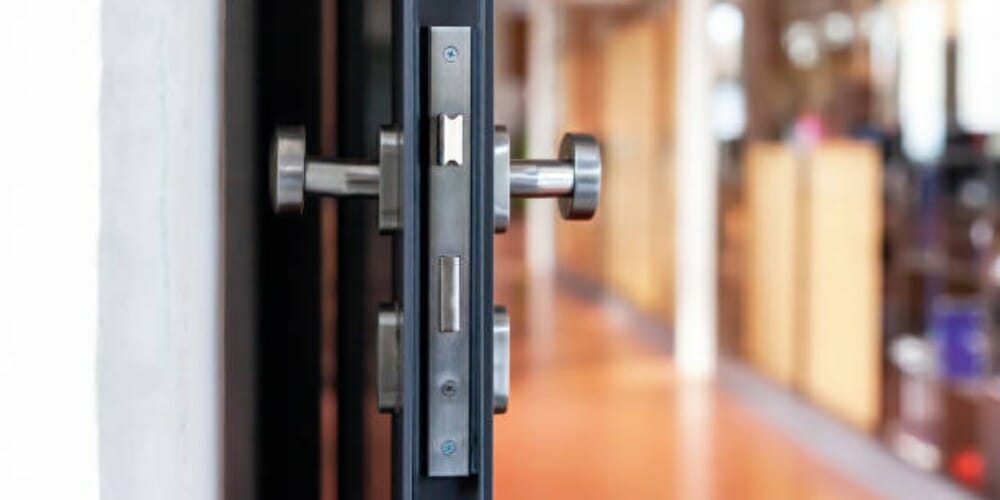Imagine coming home from an exhausting day, hankering to take a long shower to wash off the day’s fatigue. You try to open the bathroom door, but you’re locked out. Annoying. Right?
Did you know you can open a door with everyday household items? Privacy doors have door locks with a hole in them. Their designs offer privacy but not security. So, they are easy to manipulate and open with simple objects.
Follow these steps to open a door lock with a hole.
First, find a thin screwdriver. Next, slide the screwdriver into the hole. Jiggle the screwdriver. Then, swivel the screwdriver. When the screwdriver gets into the track, rotate it until you hear a click. The click means the door is open.
In this guide, we’ll explain how you can open a door lock with a hole using a:
- Screwdriver (flat head screwdriver is good)
- Plastic Card
- Force as a last resort
Let’s go into details.
1. Screwdriver Method
Screwdrivers come in handy when you have a locked door with a hole. Yet, not every screwdriver is ideal for unlocking your door.
You’ll need an eyeglass or flathead screwdriver. These two are thin and perfect to fit into the privacy lock hole of interior doors. So, if you don’t have a locksmith nearby, opening a door lock with a screwdriver is easy.
How Do You Use a Screwdriver to Open a Door Lock with a Hole?
Instead of breaking the door when you’re locked out, you can follow these five steps to open it.
Step 1: Locate the Hole
The first thing you need to do is find the hole in the lock. In most locks, the hole is always in the middle. You can identify it at a glance.
But in some locks, the hole lies sideways, and you may need to look for it in the stem or body of the doorknob.
Once you find the hole, you can proceed to the next step.
Step 2: Find a Thin Screwdriver
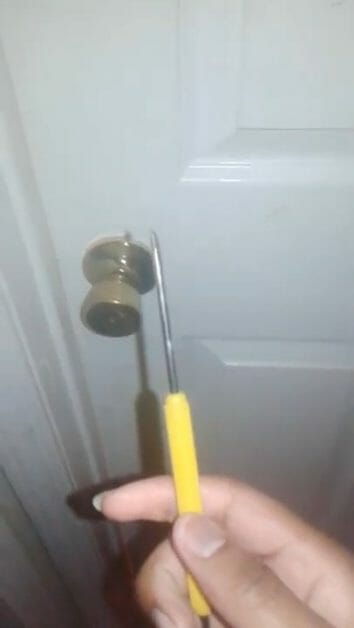
You’ll notice the hole is too small, and only thin objects can get inside. Within the hole, there is a groove which is the target.
So, you’ll need a thin but strong screwdriver with a flat head to turn the lock open. If you do not have a flathead screwdriver, you can use something similar.
Step 3: Slide the Screwdriver into the Hole
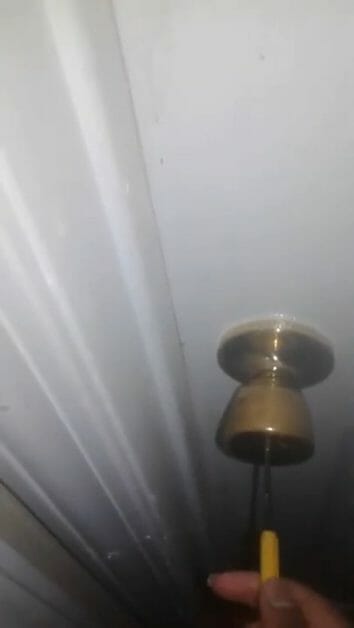
This step aims to get to the end of the hole on the doorknob where the groove is. You’ll have to push the screwdriver to the end of the hole.
It is challenging because you need to insert the screwdriver in a straight line into the door knob hole. If you fail to follow a straight line, the screwdriver may tilt on one side, and the lock won’t open.
Step 4: Jiggle the Screwdriver
The flathead comes in here. Once your screwdriver gets to the end of the hole, jiggle it around to catch the groove of the locking mechanism. The goal is to get the flathead into the groove’s indentation.
Step 5: Swivel the Screwdriver
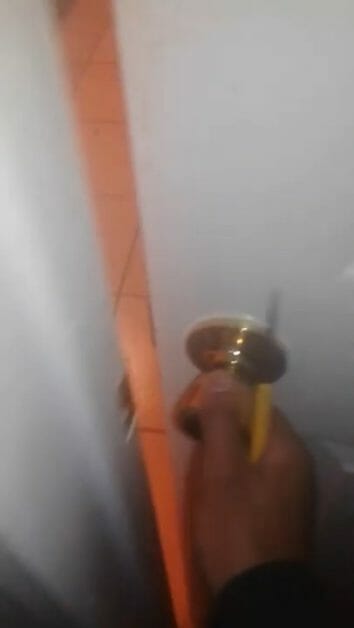
When the screwdriver gets into the groove, rotate it until you hear a click. The click means the door is now open and the locking mechanism is disabled.
Sometimes the process may not work on the first try. If your lock fails to open, remove the screwdriver and repeat the process. Don’t use too much pressure or force the lock to disengage, as you may damage it.
2. Plastic Card Method
Have you ever wondered how they open doors with a MasterCard and slight wiggle-in movies? Is it realistic, or is it fiction? (1)
It’s not fiction, and it is a practical skill you can learn. So, if you do not have a screwdriver in the house, you can apply what you are about to learn to swing the door open.
This process is rigorous, and not every card can endure the bending and jiggling. Some, like credit cards, are thick and may break in the process.
Consider using lightweight cards such as:
- Membership cards
- Gift cards
- Insurance cards
If you do not have a plastic card, you can use a butter knife or cut a strip from a plastic water bottle.
How Do You Use a Plastic Card to Open a Door Lock with a Hole?
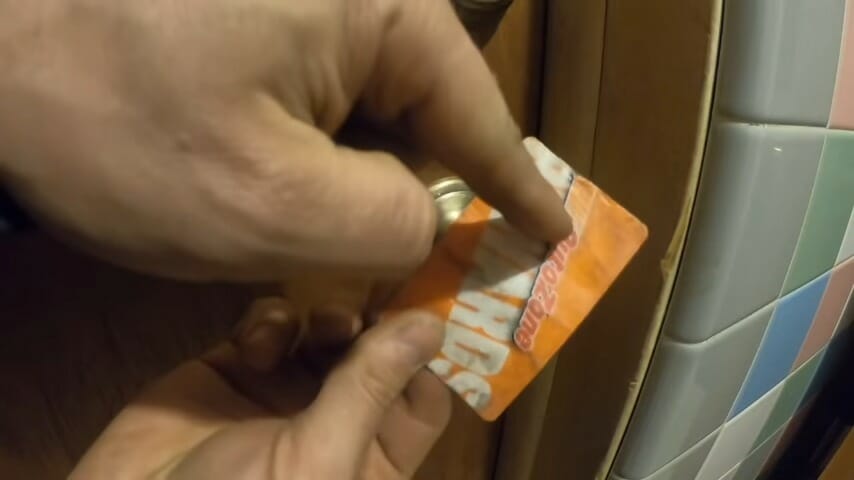
Step 1: Place the Card Vertically Between the Door and the Frame
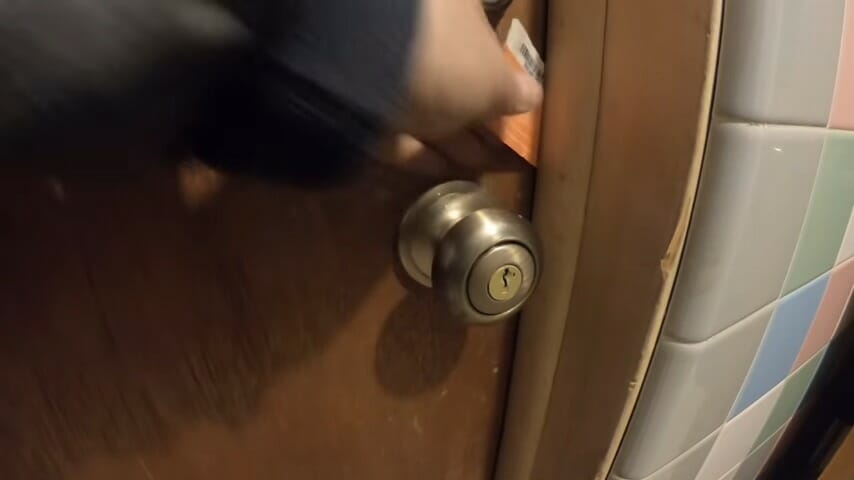
In this step, you insert the card into the crack between the door and the frame. To slide the card successfully, use one hand to push the door backward to the furthest point it can go. Then place the card perpendicularly.
Step 2: Bend the Card Towards the Doorknob
Tilt your credit card so that the side facing you almost touches the doorknob. You’ll be able to press the credit card farther into the space between the door and the door frame. That’s why it’s necessary to use a card that cannot break when bent.
Step 3: Bend the Card in the Opposite Direction
Bending the card backward causes it to slide under the arched end of the slant-latch, pushing it back into the door. Quickly unlock and open the door on the other side.
Step 4: Wiggle the Card if the Door Did Not Open
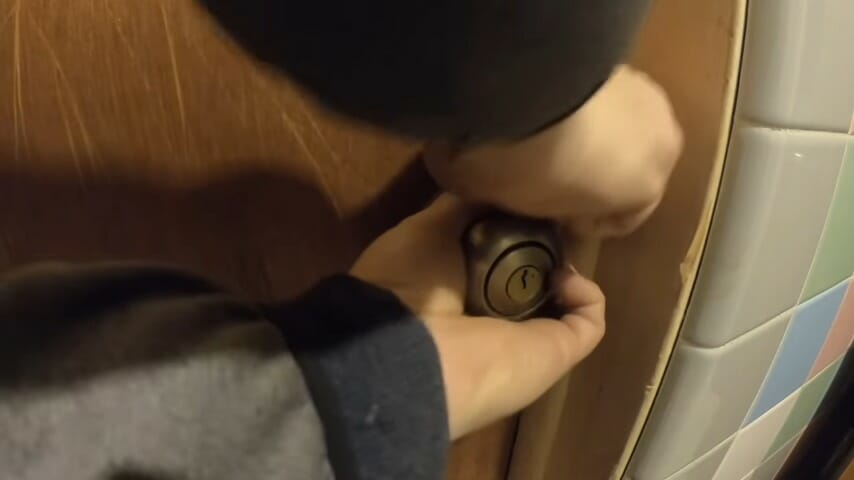
If the door fails to open, use pressure to move the card up and down. Pull and push the doorknob while wriggling the card. This helps to reduce the friction and pressure generated by the latch.
3. Use of Force as a Last Resort
In case of fire or medical emergency, you might not have time to search for a screwdriver or a plastic card. The option you have is to kick the door open using brute force.
This method is hard on a door and may damage the door lock, the frame, and the door. It is physically taxing and can result in injuries. Only use it if you are strong and physically fit.
- Find the best spot to hit the door. It should be around the doorknob and not at the center of the door.
- Stand firmly facing the door and lift your dominant leg straight towards the door.
- Kick the spot you identified using the flat or bottom of your foot.
- Hit the door repeatedly until the lock disengages from the door. Only use your feet as they can absorb strong force, and shoes protect them.
Wrapping Up
The next time you’re locked out of a room, you don’t have to call a locksmith. Find a flat head screwdriver or a plastic card in the house and follow the steps in this guide.
Always stay prepared for such situations by having a flathead screwdriver. And don’t dispose of your plastic cards as you might need them to open a locked door. By learning these skills, you’ll save money and time. (2)
Take a look at some of our related articles below.
References
(1) MasterCard – https://www.investopedia.com/articles/personal-finance/020215/visa-vs-mastercard-there-difference.asp
(2) save money – https://bettermoneyhabits.bankofamerica.com/en/saving-budgeting/ways-to-save-money
Video References
TGN
Innovator

